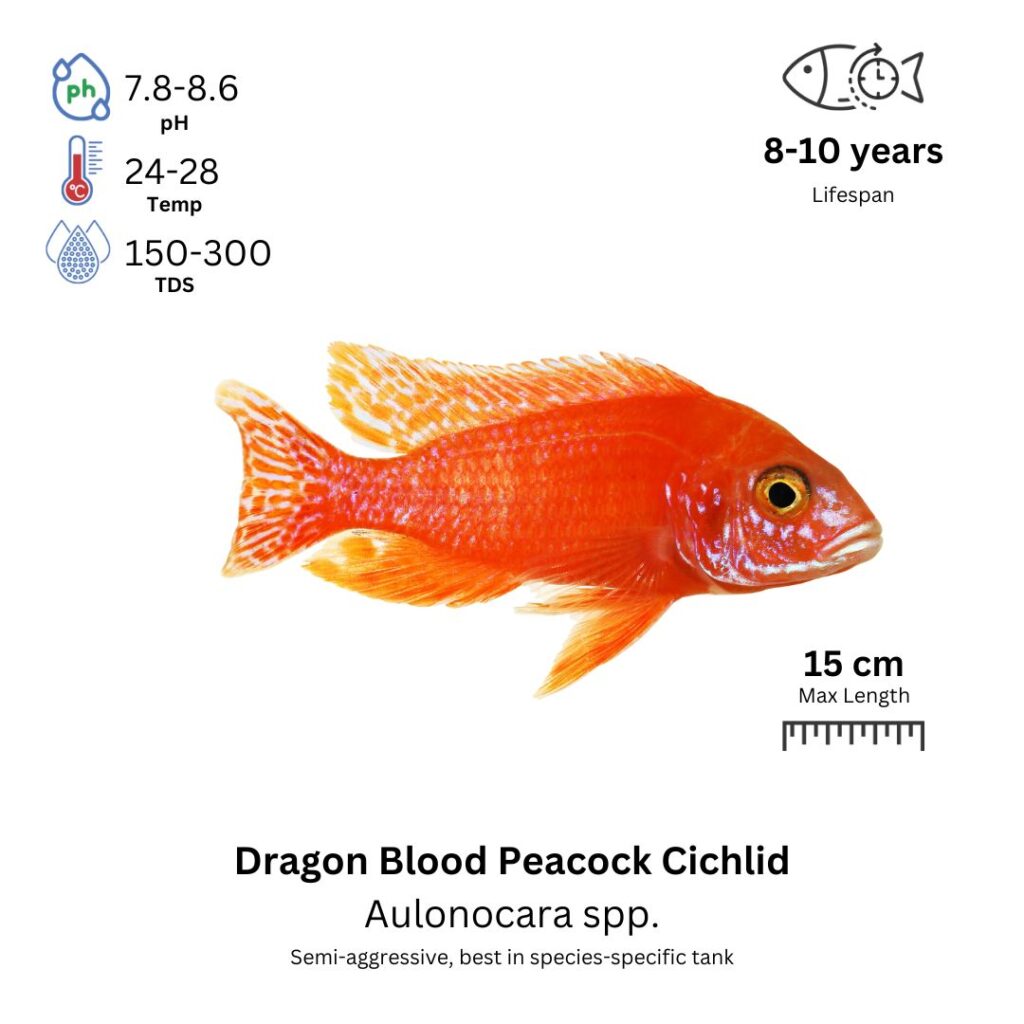Dragon Blood Peacock Cichlid
Aulonocara sp.

Description
The Dragon Blood Peacock Cichlid is a striking and popular hybrid cichlid, known for its intense coloration and vibrant patterns. This species is a result of breeding between different Aulonocara species, particularly the Aulonocara stuartgranti (commonly known as the Peacock Cichlid). The Dragon Blood Peacock features a brilliant red-orange body, often with hues of blue, yellow, and purple, creating a captivating contrast that makes them one of the most stunning fish in the aquarium trade. The males are typically more colorful and display the full range of their vibrant hues, particularly during breeding periods, while females tend to be less colorful and more subdued in appearance.
Habitat Origin
The Dragon Blood Peacock Cichlid is native to the rocky shores of Lake Malawi in East Africa, where they inhabit the rocky and sandy areas near the shore. In their natural habitat, they prefer well-oxygenated waters with a neutral to slightly alkaline pH and a temperature range similar to their aquarium needs. These cichlids are found at depths of 5 to 40 meters, where they live among the rocks, often retreating into crevices for shelter.
Aquarium
Ideal Number in Aquarium: Best kept singly or in small groups of 1 male and multiple females. Avoid keeping multiple males in small spaces to reduce aggression.
Favorite Food

Dragon Blood Peacock Cichlids are omnivores and primarily eat a varied diet consisting of high-quality pellets, live or frozen foods like brine shrimp, bloodworms, daphnia, and krill. They will also graze on algae and plant matter, so supplementing their diet with vegetable-based foods like spirulina or blanched zucchini can benefit them. A well-rounded diet will help them maintain their brilliant coloration and overall health.
Behavior:
Dragon Blood Peacock Cichlids are known for their relatively peaceful behavior compared to other cichlids, especially in a community tank. However, males can be territorial and aggressive during breeding periods or when defending their space. They are active swimmers, often seen in the middle to upper regions of the tank, and are also very intelligent, making them an interesting species to observe. They will often display courtship behavior, with males exhibiting their bright colors and showing off their fins to attract females.
Special Care:
Dragon Blood Peacock Cichlids require a stable and well-maintained environment. Regular water changes, good filtration, and a well-planted or rocky tank setup are essential for their health. These fish enjoy tanks with plenty of hiding spots, such as rocks and caves, where they can retreat to feel safe. While they are relatively hardy, they are sensitive to poor water quality and should not be kept with overly aggressive or large fish that may stress them out.
Compatibility with Other Fish:
Dragon Blood Peacock Cichlids can be housed with other peaceful African cichlids, such as smaller Mbuna species, Tanganyika cichlids, or peaceful non-cichlids. They should be kept with species that are not overly aggressive, as Dragon Blood Peacocks can be intimidated by larger or more dominant fish. Tankmates should be chosen based on size and temperament, and it’s best to avoid keeping them with aggressive cichlids or fish that are too similar in color or shape, as this may lead to territorial disputes.
Breeding Tank Setup
For breeding Dragon Blood Peacock Cichlids, a separate tank is highly recommended to minimize territorial aggression and maintain stable water conditions. A tank of 150–200 liters (40–50 gallons) is ideal, providing ample space for the breeding pair and their future fry. Maintain water parameters at a pH of 7.8–8.4, temperature between 26–30°C, and hardness of 10–15 dGH. Use a canister or external filter to manage the high bioload, but ensure water flow is not too strong. For substrate, opt for fine gravel or sand, and add flat rocks, caves, or ceramic pots to provide spawning surfaces and shelter. Standard lighting with some shaded areas will help reduce stress, particularly for females.
Selecting Breeders & Conditioning
To condition Dragon Blood Peacocks for breeding, offer a high-protein, varied diet. Include live or frozen foods such as brine shrimp, bloodworms, and daphnia, and supplement with high-quality cichlid pellets. This nutritional boost helps females develop eggs and males show vibrant courtship displays. Perform regular water changes (20–30%), and consider increasing the temperature slightly to around 28°C to trigger breeding behavior. Consistency in diet and water quality is key to achieving successful spawning.
Spawning Process
Spawning usually occurs when the male begins chasing and displaying to the female in a vibrant courtship dance. Once receptive, the female lays her eggs on a flat surface, and the male fertilizes them. Dragon Blood Peacocks are mouthbrooders; the female collects the fertilized eggs into her mouth for incubation. A healthy female can produce 50–200 eggs depending on her size. After egg laying, it’s best to separate the female, allowing her to incubate the eggs without harassment from the male or other fish.
Fry Care & Development
Eggs typically hatch within 3–4 days, but the fry remain in the female’s mouth for another 2–3 weeks until they are ready to be released. Once the fry are free-swimming, begin feeding them infusoria, liquid fry food, or finely crushed pellets. Gradually introduce baby brine shrimp or powdered cichlid food as they grow. Keep the tank clean with small, regular water changes (10–15% every 2–3 days), and maintain a stable temperature between 26–30°C. A sponge filter is ideal to ensure gentle filtration without disturbing the fry.
Maturity, Sexing & Stress Prevention
Dragon Blood Peacocks are typically ready for breeding at 1–2 years of age, depending on their health and growth rate. Males are more colorful and slender, showcasing reds, oranges, and blues, especially during breeding. Females are less vibrant, rounder, and larger, particularly when holding eggs. To avoid stress, do not overcrowd the breeding tank and maintain consistent water conditions. Avoid sudden changes in pH, temperature, or hardness, and remove any aggressive or fast-moving tankmates that could disrupt the breeding cycle.
